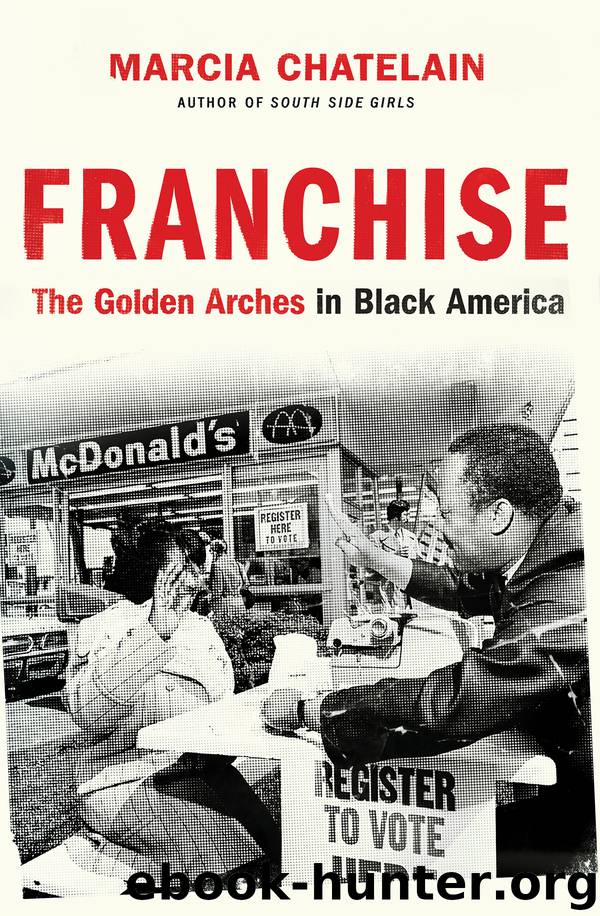Franchise by Marcia Chatelain

Author:Marcia Chatelain
Language: eng
Format: epub
Publisher: Liveright
Published: 2019-11-05T16:00:00+00:00
Like virtually all of my fellow workers, I liberated McDonaldland cookies by the boxful, volunteered to clean “lots and lobbies” in order to talk to my friends, and accidentally cooked too many Quarter Pounders and apple pies near closing time, knowing fully well that we could take home whatever was left over.44
The complicated nature of fast food work could never be fully represented in a Burrell Communications ad, but for black viewers who were proximate to the experience of working fast food, Calvin’s smile and enthusiasm may have been the subject of skepticism, and for white audiences, the disruption of stereotype may have been instructive. Targeted advertisements are not in the business of selling hard truths even when they are designed to refute ugly vestiges of racism, but the lens through which viewers read them provide a challenge to advertisers who must speak with many voices through a singular mouthpiece. Burrell’s advertisements did not shy away from referring to the urgency of black America’s need for jobs or pathways to professional careers, but each reminder of the obstacles to black equality led to an assurance that McDonald’s was lighting the way.
* * *
McDonald’s advertising to black consumers seemed more concerned with the heart and soul than with the stomach, but as more black consumers entered the category the industry calls “super heavy users,” McDonald’s knew that it was worthwhile and advantageous to develop products that catered specifically to this population. In a 1977 report, the distinctions between a heavy and light fast food user showed how race and class informed market segmentation. Heavy users represented 48% of their customers and tended to be “younger, male and blue collar occupationally,” and on the whole heavy users were “non-white, principally black, but also other racial minorities.” Light users by contrast were “substantially older, female, white and somewhat better educated.”45 The initial fast food staples of hamburgers, hot dogs, fried chicken, and tacos were bestsellers in the consumer market. But companies knew that in order to increase their market share they needed to continually improve and expand their menus, while still maintaining strong profits and keeping prices low. Although McDonald’s was a leader in the fast food space, it was particularly timid in its expansion of its menu. Most of the popular revisions to the menu boards were introduced by franchisees. From the Filet-O-Fish to the Shamrock Shake, local operators used regional tastes to pitch additions to the national roster of selections. This was a point of pride for Kroc, who was not as adept at identifying and cultivating culinary trends for the restaurant as he was at selling billions of burgers.46 For every successful product or concept, such as the Big Mac and the McMuffin, there were more false starts, including the east European pastry kolache and a roast beef sandwich.47 When McDonald’s unveiled new products, they did so with considerable attention to the customers that would be most drawn to them. As Burrell Communications created vibrant images of “real” black life for McDonald’s, ViewPoint helped them strategize on how to please black palates.
Download
This site does not store any files on its server. We only index and link to content provided by other sites. Please contact the content providers to delete copyright contents if any and email us, we'll remove relevant links or contents immediately.
Life 3.0: Being Human in the Age of Artificial Intelligence by Tegmark Max(5506)
The Sports Rules Book by Human Kinetics(4339)
The Age of Surveillance Capitalism by Shoshana Zuboff(4243)
ACT Math For Dummies by Zegarelli Mark(4017)
Unlabel: Selling You Without Selling Out by Marc Ecko(3623)
Blood, Sweat, and Pixels by Jason Schreier(3583)
Hidden Persuasion: 33 psychological influence techniques in advertising by Marc Andrews & Matthijs van Leeuwen & Rick van Baaren(3515)
Bad Pharma by Ben Goldacre(3395)
The Pixar Touch by David A. Price(3389)
Urban Outlaw by Magnus Walker(3364)
Project Animal Farm: An Accidental Journey into the Secret World of Farming and the Truth About Our Food by Sonia Faruqi(3189)
Kitchen confidential by Anthony Bourdain(3045)
Brotopia by Emily Chang(3024)
Slugfest by Reed Tucker(2970)
The Content Trap by Bharat Anand(2885)
The Airbnb Story by Leigh Gallagher(2820)
Coffee for One by KJ Fallon(2599)
Smuggler's Cove: Exotic Cocktails, Rum, and the Cult of Tiki by Martin Cate & Rebecca Cate(2495)
Beer is proof God loves us by Charles W. Bamforth(2414)
